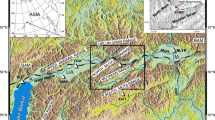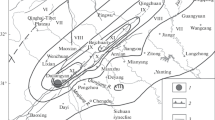Abstract
The process of the lead up and development of a catastrophic seismic event that affected the Earth’s crust and the upper mantle, which led to a change in the natural environment in the western part of the Zagros folded mountain belt, is analyzed. The macroseismic effect, the focal mechanism, the aftershock sequence, the seismotectonic position of the epicentral area, and other parameters characterizing the features of the zone of this catastrophic earthquake with magnitude М = 7.4 that occurred near the Iran–Iraq border on November 12, 2017, are described. In one settlement (Iraq, the city of Dzharband khan), a macroseismic effect corresponding to 9-points according to the Modified Mercalli Intensity scale is recorded. An area of about 150 × 100 km2 underwent impacts of 7–8 points, tremors with the intensity of 5–6 points covered an extensive area of about 800 × 700 km2, and 4- to 5-point impacts were observed all over western Iran and eastern Iraq and appeared in major cities such as Tehran, Baghdad, Kirkuk, Ahvad, and Pasht. In the period from November 12, 2017, until January 21, 2018, more than 50 aftershocks with magnitude mb = 4.2–5.6 were registered in the epicenter zone of the earthquake according to data from the Federal Research Center Geophysical Survey of the Russian Academy of Sciences (RAS). Their epicentral area extended in the near-meridional direction along the Iraq–Iran border, primarily to the south from the epicenter of the main shock. Its length reached about 210 km and width was about 60 km. The position of the epicentral field of the aftershocks makes it possible to associate the earthquake focus of November 12, 2017, with the Khanaqin fault zone of the meridional strike and dextral strike-slip kinematics. The fault crosses Zagros diagonally near the Iran–Iraq border. Given that the size of the earthquake focus is established by the distribution of epicenters of the aftershocks, it covered the Khanaqin fault zone almost over its entire length. Sufficient attention is paid to the identified prognostic effects. The data of observations from geophysical observatories reflecting the processes of earthquake lead up and development are presented. Before the earthquake of November 12, 2017, the information and measuring systems of the North Caucasus geophysical observatory of Schmidt Institute of Physics of the Earth, RAS, had recorded gravitomagnetic disturbances of the ultralow frequency range. These prognostic effects appeared a few hours before the main shock. The conditions of the origination and development of seismogravity and gravitomagnetic disturbances are specified. In light of the presented material, it becomes clear that the experimental study of a separate class of fundamental gravitomagnetism problems identified in recent years is a defining problem of geophysics today. The gravitomagnetic disturbances in the lithosphere and other geospheres of the Earth recorded at large distances from the focal area can be considered a source of information on the time of appearance of the main high-magnitude shock. To use these effects for a real prediction of the expected magnitude and location and time of the pending earthquake, it is apparently necessary to develop a monitoring network at the observatory equipped with specialized measuring systems that can detect weak gravitomagnetic and seismogravity signals in the high-interference signaling environment on the Earth.











Similar content being viewed by others
REFERENCES
Abbot, B.P., Abbot, R., Abbot, T.D., et al., Observation of gravitational waves from a binary black hole merger, Phys. Rev. Lett., 2016, vol. 116, no. 6, 061102. doi 10.1103/PhysRevLett.116.061102
Ambraseys, N. and Melville, C., A history of Persian earthquakes, New York: Cambridge Univ. Press, 1982.
Bachmanov, D.M., Trifonov, V.G., Hessami, K., Kozhurin, A.I., Ivanova, T.P., Rogozhin, E.A., Hademi, M.C., and Jamali, F.H., Active faults in the Zagros and central Iran, Tectonophysics, 2004, vol. 380, pp. 221–241. doi 10.1016/j.tecto.2003.09.021
Barsukov, O.M., Solar flares, sudden commencements, and earthquakes, Fiz. Zemli, 1991, no. 2, pp. 93–96.
Berberian, M., Contribution to the Seismotectonics of Iran (Part II), Geol. Surv. of Iran, 1976, Rep. no. 39.
Berberian, M., Master “blind” thrust faults hidden under the Zagros folds: Active basement tectonics and surface morphotectonics, Tectonophysics, 1995, vol. 241, pp. 193–224. doi 10.1016/0040-1951(94)00185-C
Berberian, M., Petrie, C.A., Potts, D.T., Asgari, Chverdi, A., Dusting, A., Sardari, ZarchiA., Weeks, L., Ghassemi, P., and Noruzi, R., Archaeoseismicity of the mounds and monuments along the Kazerun fault (Western Zagros, SW Iranian plateau) since the Chalcolithic Period, Iran. Antiqua, 2014, vol. 49. doi 10.2143/IA.49.0.3009238
Fraser-Smith, A.C., Ultralow-frequency magnetic fields preceding large earthquakes, EOS, 2008, vol. 89, no. 23, p. 211.
Gokhberg, M.B. and Shalimov, S.L., Vozdeistvie zemletryasenii i vzryvov na ionosferu (Influence of Earthquakes and Explosions on the Ionosphere), Moscow: Nauka, 2008.
Guglielmi, A.V., Ultra-low-frequency electromagnetic waves in the Earth’s crust and magnetosphere, Phys. Usp., 2007, vol. 50, pp. 1197–1216. doi 10.1070/ PU2007v050n12ABEH006413
Guglielmi, A.V., Sobisevich, L.E., Sobisevich, A.L., and Lavrov, I.P., Foreshocks of strong earthquakes, Izv., Phys. Solid Earth, 2014, vol. 50, no. 4, pp. 501–507. doi 10.1134/S1069351314040053
Guglielmi, A.V., Lavrov, I.P., and Sobisevich, A.L., Storm sudden commencements and earthquakes, Sol.-Terr. Phys., 2015, vol. 1, no. 1, pp. 98–103. https://elibrary. ru/item.asp?id=25272092.
Hessami, K., Koyi, H.A., and Talbot, C.J., The significance of strike-slip faulting in the basement of the Zagros fold and thrust belt, J. Petrol. Geol., 2001, vol. 24, pp. 5–28. doi 10.1111/j.1747-5457.2001.tb00659
Kopytenko, Yu.A., Ismagilov, V.S., Kopytenko, E.A., Voronov, P.M., and Zaitsev, D.B., Magnetic location of geomagnetic disturbance sources, Dokl. Earth Sci., 2000, vol. 371, no. 3, pp. 569–571.
Lin’kov, E.M., Petrova, L.N., Savina, N.G., and Yanovskaya, T.B., Ultralong-period oscillations of the Earth, Dokl. Akad. Nauk, 1982, vol. 262, no. 2, pp. 321–324.
Lin’kov, E.M., Petrova, L.N., and Osipov, K.Ts., Seismogravity pulsations of the Earth and atmospheric disturbances as a possible precursor of strong earthquakes, Dokl. Akad. Nauk, 1990, no. 5, pp. 1095–1098.
Liperovskii, V.A., Gladyshev, V.A., and Shalimov, S.S., Lithosphere–ionosphere relations before earthquakes, Izv. Akad. Nauk SSSR, Fiz. Zemli, 1991, no. 3, pp. 26–35.
Rogozhin, E.A., Seismotectonic features of the September 24, 1999 Ahram earthquake in the Zagros, Iran, Geotectonics, 2012a, vol. 46, no. 5, pp. 369–378. doi 10.1134/S0016852112050044
Rogozhin, E.A., Ocherki regional’noi seismotektoniki (An Outline of Regional Seismotectonics), Moscow: IFZ RAN, 2012b.
Rogozhin, E.A. and Sobisevich, L.E., Wave disturbances induced by crustal earthquakes: Case study of two strong earthquakes in the Caucasian–Anatolian sector of the Alpine Mediterranean mobile belt, Izv., Phys. Solid Earth, 2014, vol. 50, no. 2, pp. 296–304. doi 10.1134/S1069351314020086
Rogozhin, E.A., Lutikov, A.I., Sobisevich, L.E., To Shen, and Kanonidi, K.Kh., The Gorkha earthquake of April 25, 2015 in Nepal: Tectonic position, aftershock process, and possibilities of forecasting the evolution of seismic situation, Izv., Phys. Solid Earth, 2016, vol. 52, no. 4, pp. 534–549. doi 10.1134/S1069351316040078
Schekotov, A.Y., Molchanov, O.A., Hayakawa, M., Fedorov, E.N., Chebrov, V.N., Sinitsin, V.I., Gordeev, E.E., Belyaev, G.G., and Yagova, N.V., ULF/ELF magnetic field variations from atmosphere induced by seismicity, Radio Sci., 2007, vol. 42, no. 6, RS6S90.
Sobisevich, A.L., Izbrannye zadachi matematicheskoi geofiziki, vulkanologii i geoekologii (Selected Problems of Mathematical Geophysics, Volcanology, and Geoecology), Moscow: IFZ RAN, 2012, vol. 2.
Sobisevich, A.L., Sobisevich, L.E., Kanonidi, K.K., and Likhodeev, D.V., Gravimagnetic perturbations preceding earthquakes, Dokl. Earth Sci., 2017, vol. 475, no. 2, pp. 891–894. doi 10.1134/S1028334X17080086
Vallée, M., Ampuero, J.P., Juhel, K., Bernard, P., Montagner, J.-P., and Barsuglia, M., Observations and modeling of the elastogravity signals preceding direct seismic waves, Science, 2017, vol. 358, no. 6367, pp. 1164–1168. doi 10.1126/science.aao0746
Wells, D.L. and Coppersmith, K.J., New empirical relationships among magnitude, rupture length rupture width, rupture area, and surface displacement, Bull. Seismol. Soc. Am., 1994, vol. 84, no. 4, pp. 974–1002.
ACKNOWLEDGMENTS
It is a great privilege for us to appreciate our outstanding scientist Doctor of Physics and Mathematics V.V. Kuz’minov for continuously supporting the activities at the North Caucasus Geophysical Observatory, Schmidt Institute of Physics of the Earth, RAS, since the first two laboratories were established in 2000 at the tunnels of the unique Baksan Neutrino Observatory of Institute for Nuclear Research, RAS, which has been under his permanent management.
This work was supported by a grant from the president of the Russian Federation to support scientific schools, no. NSh-5545.2018.5.
Author information
Authors and Affiliations
Corresponding author
Additional information
Translated by L. Mukhortova
Rights and permissions
About this article
Cite this article
Rogozhin, E.A., Sobisevich, A.L., Sobisevich, L.E. et al. On the Devastating Earthquake at the Iran–Iraq Border. Izv. Atmos. Ocean. Phys. 54, 867–878 (2018). https://doi.org/10.1134/S0001433818080108
Published:
Issue Date:
DOI: https://doi.org/10.1134/S0001433818080108




